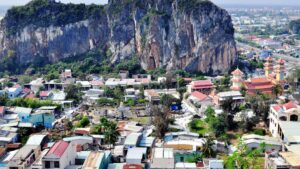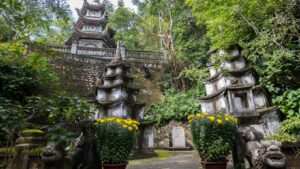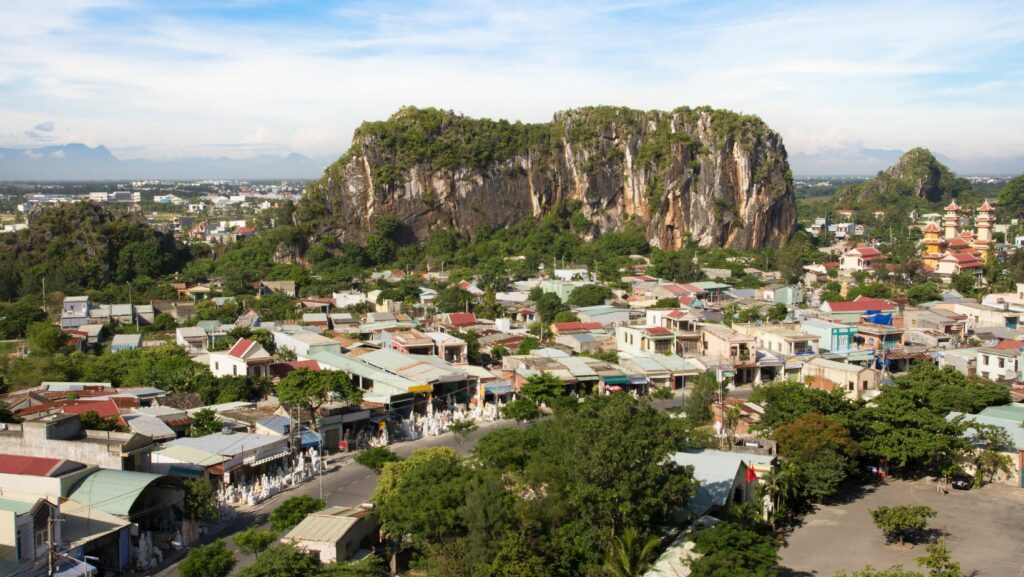Nestled in the heart of Vietnam, the Marble Mountains stand as a testament to the country’s rich natural beauty and cultural heritage. This cluster of five limestone and marble hills, each named after an element—metal, wood, water, fire, and earth—offers a unique blend of natural wonders and spiritual sanctuaries. Travelers and locals alike find themselves mesmerized by the intricate caves, ancient pagodas, and breathtaking panoramic views.
Marble Mountains Vietnam
 Marble Mountains Vietnam are a cluster of five limestone and marble hills located in Da Nang. These hills are named after the five elements: Metal, Water, Wood, Fire, and Earth. Each mountain has its unique features, including caves, tunnels, and Buddhist sanctuaries.
Marble Mountains Vietnam are a cluster of five limestone and marble hills located in Da Nang. These hills are named after the five elements: Metal, Water, Wood, Fire, and Earth. Each mountain has its unique features, including caves, tunnels, and Buddhist sanctuaries.
The Marble Mountains hold significant historical and cultural value. Local legends suggest that the mountains’ formation is tied to mythical stories. For centuries, these mountains have been centers for Buddhist worship. Ancient pagodas and statues found here illustrate Vietnam’s spiritual heritage, with many structures dating back to the Nguyen Dynasty (1802-1945).
Key Attractions
- Thuy Son (Water Mountain): Known for its stunning caves, and a central location. Key sites include the Linh Ung Pagoda and Huyen Khong Cave.
- Am Phu Cave: Offers a unique “Hell Cave” experience. Contains altars, tunnels, and a detour illustrating Buddhist depictions of hell.
- Tam Thai Pagoda: Built in the 17th century. Features intricate architectural details, providing insight into the region’s religious art.
Visiting Tips
Travelers visiting Marble Mountains Vietnam can access local guides for detailed tours. Comfortable shoes are crucial due to uneven terrain. Early morning or late afternoon visits offer moderate temperatures and fewer crowds. Local vendors provide refreshments and souvenirs near the site.
How to Get There
 Marble Mountains are close to Da Nang, accessible by car, bike, or taxi. The site is roughly 8 kilometers south of the city center, making it a convenient excursion from nearby Hoi An and other coastal areas.
Marble Mountains are close to Da Nang, accessible by car, bike, or taxi. The site is roughly 8 kilometers south of the city center, making it a convenient excursion from nearby Hoi An and other coastal areas.
- Non Nuoc Beach: Located at the base of Marble Mountains. Offers pristine sands and clear waters.
- Hoa Nghiem Cave: Situated within Thuy Son. Contains a Buddhist shrine wrapped in natural beauty.
- Ngu Hanh Son Stone Village: Known for its stone-carving tradition. Craftspeople here create detailed sculptures and ornaments.
Historical Significance
Marble Mountains Vietnam boasts a rich history intertwined with ancient legends, cultural importance, and historical milestones.
Cultural Importance
The cultural importance of the Marble Mountains is evident through their historical ties to Vietnamese Buddhism and Cham culture. Several pagodas and sanctuaries can be found within the mountains, many of which date back to the Nguyen Dynasty. These religious sites serve as places of worship and reflection, attracting monks, nuns, and pilgrims. Additionally, the mountains showcase traditional Vietnamese architecture and art, with intricate carvings and statues depicting Buddhist deities and folklore characters. The preservation of these cultural artifacts provides insight into Vietnam’s rich spiritual heritage and architectural ingenuity.
Key Attractions
Marble Mountains, rich in history and culture, host several key attractions. These sites draw visitors with their unique experiences and historical significance.
Am Phu Cave
Am Phu Cave, known as the Hell Cave, offers an unforgettable journey through its dark, intricate tunnels. Visitors explore various chambers representing Buddhist hell’s levels. Illuminated sculptures and carvings provide a chilling yet intriguing insight into spiritual beliefs. The cave, resembling a labyrinth, creates an eerie environment, attracting those fascinated by religious symbolism and adventure.
Visitor Experience
Marble Mountains in Vietnam offer a rich and enjoyable visitor experience, blending history, culture, and nature.
Best Time to Visit
 The ideal time to visit Marble Mountains is from February to May. During these months, the weather remains pleasant with low humidity and temperatures ranging from 20°C to 30°C.
The ideal time to visit Marble Mountains is from February to May. During these months, the weather remains pleasant with low humidity and temperatures ranging from 20°C to 30°C.
This period ensures comfortable exploration of the mountains and minimizes the risk of heavy rainfall disrupting outdoor activities.
Climbing Tips
Climbing Marble Mountains requires a moderate fitness level due to steep and uneven steps. Visitors should wear comfortable footwear with good grip and bring water to stay hydrated. For added safety, early mornings or late afternoons are preferable times to climb, avoiding the midday heat. Visitors can take breaks at various pagodas and caves, enjoying both rest and exploration along the ascent.
In Conclusion
The Marble Mountains in Vietnam offer a unique blend of natural beauty and cultural richness. Visitors can explore ancient pagodas and caves that tell the story of Vietnam’s past while enjoying the serene landscapes. The area’s historical and religious significance makes it a must-visit for anyone interested in Vietnamese heritage.

